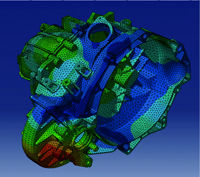Major Noise Generation Mechanisms
Gear whine is a tonal noise that occurs at orders of engine rpm which correspond with the number of teeth in the different gear pairs. Gear whine can result from several causes, a main one being errors in manufactured tooth geometry or shape, another one being excessive intentional modifications to tooth shape (like tip and root relief) that affect conjugacy in mating pairs of gears. However, gear whine is also caused by variation in the rotational stiffness of contact between two gear pairs. This stiffness varies as a function of time for two
different reasons. The number of teeth in contact can vary through each revolution, with two teeth being in contact at one point in time and three at another, for example. Also, the point of contact on a given gear pair continually moves along the face of the teeth. One can view each tooth as a beam that is clamped at its root. The bending stiffness of these beams changes as the contact point moves along the beam. For one given tooth, the stiffness rises as the contact point moves towards the root diameter and falls as the contact point moves towards the outer
diameter. This phenomenon accounts for additional stiffness variation as a function of time.
Gear rattle results from the fact that non-power transmitting gears are free to move within boundary limits defined by the tangential clearance between the teeth of different gears and the radial and axial clearance between gear and shaft. These gears impinge upon other gears and shafts, resulting in metal-to-metal impacts. These impact forces generate a wideband vibration frequency content. The impacts are driven by engine speed fluctuations due to
combustion forces. Gear whine and rattle sources are transferred to the shaft bearings, which finally excite the transmission housing. The housing vibrates and acts as a noise radiator.
Move from Build and Test to CAE
Today, transmission manufacturers typically address these problems by spending considerable time and energy during the prototype testing phase evaluating transmission noises occurring when gears are being shifted, as the engine is accelerated in various gears, while idling, etc. The problem with this approach is that it’s very expensive and time-consuming to build prototypes, perform physical testing and then modify the prototypes in an effort to solve the problem. Another problem is that the amount of information provided by physical testing is limited by the number and accuracy of sensors that can be used to instrument the transmission.Many important areas, such as the gear teeth, are difficult or impossible to instrument.
For these reasons, Elasis has in the last several years begun working to develop CAE methods to evaluate and understand gearbox noise in the design stage when prototypes are not available. The aim is to be able to optimize the design while reducing or eliminating the need for troubleshooting during the prototype phase. One approach that has been used successfully by LMS is to focus on the analysis of the transmission housing, analyzing how the transmission housing vibrates and radiates noise under known forces at the bearings and how this noise is transmitted to the vehicle interior. The transmission housing can be modeled using finite element (FE) and boundary element models, and the forces at the bearing can be identified by means of experimental methods, such as transfer path analysis. This combined test-CAE simulation can be used to identify weaknesses in the housing and make corrections such as adding ribbing, changing wall thickness, etc.
This method can be used based on forces identified on the current design of the gearbox, if the box is already available for testing, or with realistic forces defined from experience with similar types of gearboxes. This approach is appropriate when the noise problem lies in resonances of the gearbox housing, which amplifies the internal forces generated at the bearings. However, when the problem is mainly due to high excitation forces, the solution cannot always be found in structural housing modifications, and another approach must be used.
Eliminating Noise at its Source
Elasis is a Fiat-owned engineering company that works mainly for Fiat Auto and on the Fiat-GM Powertrain joint venture (FGP), carrying out research and development on vehicles and powertrains. In the current project, LMS and Elasis set out to go beyond the above method by analyzing in detail the sources of the noise in a new transmission. The challenge was modeling the full complexity of the internal operation of the transmission to the level of detail required to accurately predict internal dynamic forces in the wide frequency range associated with gear rattle.
LMS engineering specialists developed an approach that combines multibody simulation and boundary element analysis to capture the root causes of noise generation within the transmission. The first step was using LMS DADS software to create a dynamic model of the internal transmission mechanism that incorporates gear stiffness, gear backlash, bearing characteristics, and hub and sleeve connection properties. The flexibility of components, such as the shaft and housing, was represented by using modal parameters obtained from FE models.








